A well-planned, high-quality environment can support infants’ and toddlers’ social-emotional development and learning. This lesson describes how your infant and toddler early care and learning environment can promote social-emotional growth.
辅助标签
- 确定环境可以促进婴儿和幼儿的社会情绪发展的方式。
- 探索环境如何有助于提供额外的支持并防止具有挑战性的行为。
- 了解支持家庭的方法,以考虑他们的家庭环境作为促进婴儿和幼儿的社会情感发展的机会。
学
知道
Research highlights that the quality of a caregiving environment has a significant impact upon a young child’s future. Creating an environment that promotes relationship building and fosters healthy social interactions takes intentionality and planning. When planning your early care and learning environment, it is important to think about caregiving routines and ways to integrate family culture into the environment. Your goal is to create environments that support the social-emotional development of all infants, toddlers and families, including those infants and toddlers who are particularly vulnerable because of stress, poverty or other adverse early experiences. This lesson will explore ideas about high-quality, supportive environments as a way to support the social-emotional development of all infants and toddlers in your care.
Creating Environments that Support Children’s Social-Emotional Development
在幼儿的社交情绪发展和学习时应考虑以下高质量,支持环境的特点:狗万app怎么下载
Nurturing relationships:早期护理和学习环境中培养和响应关系的质量和可靠性对于健康的社会情感发展和学习至关重要。狗万app怎么下载研究突出了整体健康发展(物理,认知,情感,社会和行为)取决于幼儿与父母和照顾者的关系的质量和可靠性。看护人可以:
- 创建欢迎和鼓励家庭参与的环境
- 观察并密切关注婴儿和幼儿,以促进环境中的联系,减少冲突
- Interact with infants and toddlers to match their temperament style, provide predictable and consistent experiences, facilitate verbal and nonverbal communication, and encourage safe exploration and problem solving
- 支持家庭接触认识到斯特恩gths of families, encouraging communication and shared ideas, and focusing on the infant, toddler and family while showing appreciation for their cultural identify
Early Brain Development:Environments make a difference in brain development. Environments that provide consistent, warm and nurturing care, proper nutrition, periods of sleep, and physical activity help prepare the brain to function and develop optimally. Caregivers can:
- 提供和支持定期安排的睡眠和休息惯例,以及运动和体力活动
- 及时回应婴儿和幼儿的需求。
- Share information about early brain development with families.
- 了解社区资源。发展筛查可以帮助识别和理解可能会干扰大脑对经验的自然反应的可能性早期感官缺陷。
护理人员还可以使用“服务和返回”过程与婴儿和幼儿进行交互。哈佛大学发展中国家中心创始总监Jack Shonkoff博士将“服务和返回”为健康大脑发展的关键。当幼儿通过像短语和面部表情这样的东西征求互动时发生这种情况 - 服务和成年人分享并支持婴儿或蹒跚学步的经验或注意力的重点。要了解有关“服务和返回”的更多信息,您可以从开发的孩子的中心访问视频剪辑,http://developingchild.harvard.edu/resources/multimedia/videos/three_core_concepts/serve_and_return/
Predictable and Responsive Routines and Schedules: Responsive routines and schedules are designed with close attention to an infant's and toddler’s temperament, strengths, developmental needs, and culture, and help provide direction when caring for infants and toddlers.
婴儿和幼儿开发独特的日常节奏和模式,用于进食,睡觉和积极的警觉性。例如,一些婴儿可以快速完成瓶子然后睡着了。当护理人员遵循婴儿或幼儿的铅和构建自然习惯的惯例时,惯例自然发展。
To provide and support predictable and responsive routines and schedules, caregivers can:
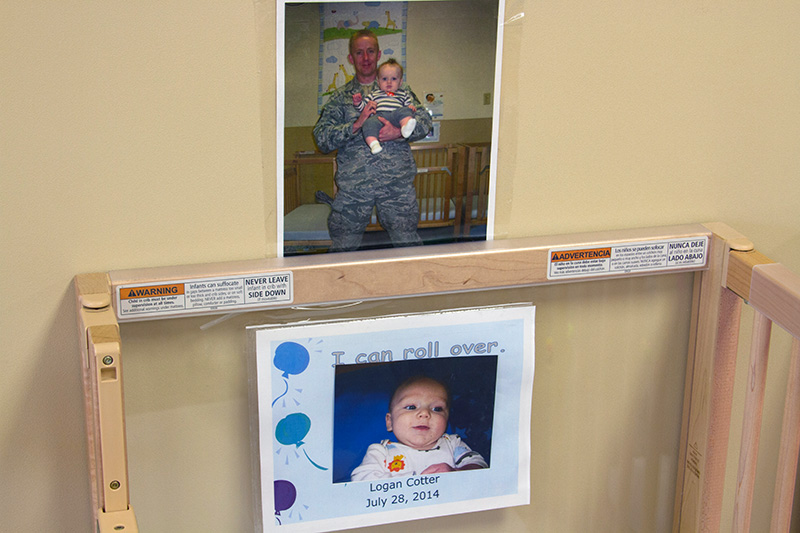 创建婴儿,幼儿和家庭看到自己的环境(例如,婴儿,幼儿和家庭,文化熟悉的材料和食物,使用家庭语言的沟通)。
创建婴儿,幼儿和家庭看到自己的环境(例如,婴儿,幼儿和家庭,文化熟悉的材料和食物,使用家庭语言的沟通)。- Provide a comfortable space for families to be with their infant or toddler during hellos and good-byes.
- 创建并发布日程表,并介绍儿童眼睛水平日常日常生活的图片,并具有可用于讨论,查看和触摸。
- 提前准备材料并建立活动(例如,有涂料和刷子准备好艺术品)。
- 最大限度地减少在转型中包括幼儿的等待时间:“卡森,在我拿出纸时,你拿着一盒蜡笔。”
Safe and appropriate materials:当环境没有健康和安全危险时,婴儿和幼儿可以安全地探索,而他们的看护人可以探讨并可以阅读他们的提示,而护理人员可以为婴儿和幼儿提供材料的支持表明兴趣和好奇心。看护人可以:
- 帮助保持材料清洁和安全的婴儿和幼儿。
- 将成人袋和物品存放在婴儿和幼儿的范围之外。
- Place padding under indoor climbers.
- 将清洁材料存放在锁定柜中。
- 创建空间,幼儿可以仔细地骑自行车和其他玩具。
- 去除破碎的玩具或播放材料。
- 提供并使用像家庭样品。
- 反映家庭体验的物品(服装,梳子,工具,安全厨房用具)
- Different types of paper (coloring paper, paper grocery bags, wrapping paper) to crumple and draw on
- 量杯和勺子用沙子和water table
- Provide materials to explore with their senses (seeing, hearing, touching, tasting and smelling).
- Provide duplicates of favorite play items.
- 在REACH中显示玩具,以便婴儿和幼儿可以看到可用的是什么并做出选择。
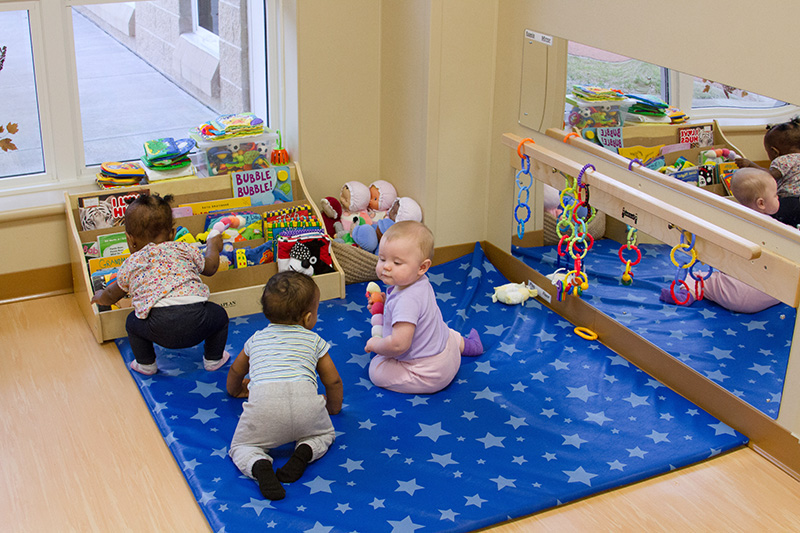
个性化护理:每个婴儿和幼儿都是独一无二的,这需要看护人来整理个人化。通过确保有足够的成年人能够安全地照顾婴儿和幼儿,可以实现个性化的护理,并提供主要的护理和关注的连续性。以下是来自首脑局办公室的两个资源,国家资源中心(2014)提供有关婴幼儿和幼儿的个性化护理的更多信息。第二个资源,第二部分,提供了一个四部分循环,即护理人员可以与个性化护理啮合:
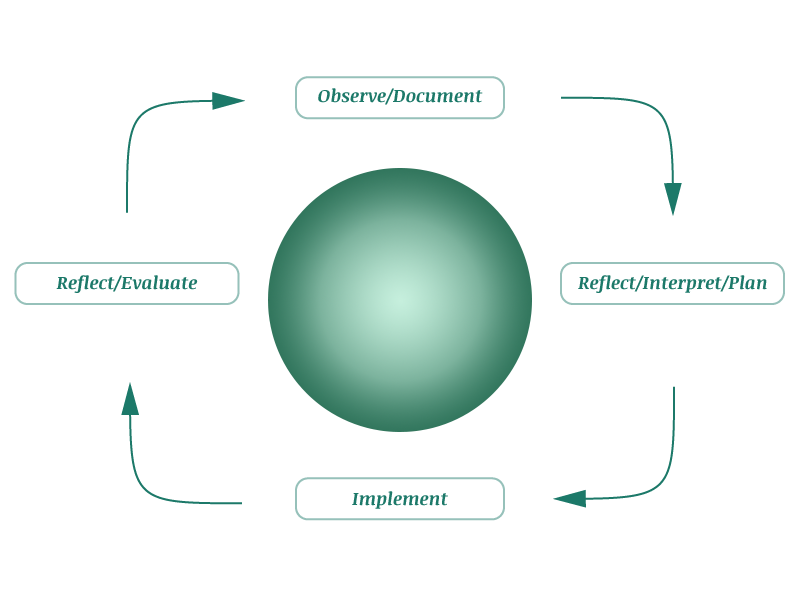
Source: Early Head Start National Resource Center (2014).婴儿和幼儿的个性化护理 - 第2部分. U.S. Department of Health and Human Services, Administration for Children and Families. Washington, DC.
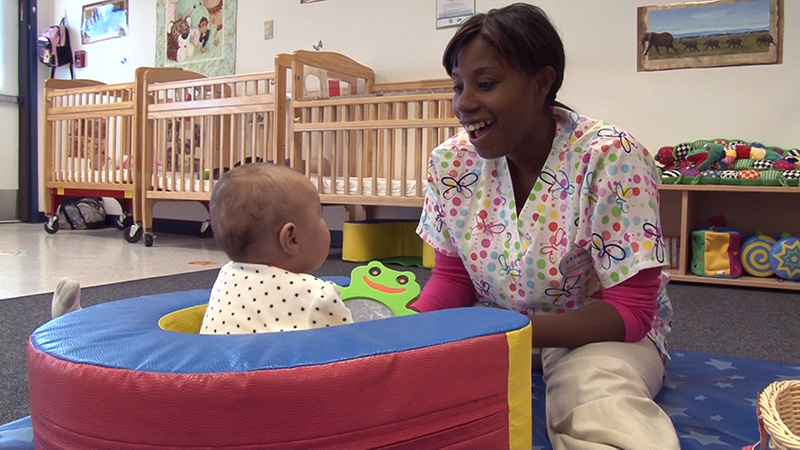
Self-regulation:包括足够数量的响应,培育和技术护理人员的环境足以让孩子们与安全的边界自由移动,并且旨在支持安静和积极的游戏中的接触将有助于支持自我调节的发展是社会情绪发展的核心组成部分。
Early care and learning environments affect social-emotional development in many ways. By surrounding infants and toddlers with responsive, nurturing, and skilled adult caregivers, relationships can be strengthened and infants’ and toddlers’ needs can be acknowledged and met. Information can be shared with families about the infant or toddler to maintain consistency across environments and experiences. This consistency is key to young children’s growth and learning. Within the Explore section of this lesson, you will have an opportunity to reflect on and learn more about strategies to continue supporting the social-emotional development of the infants and toddlers in your care.
环境作为支持和帮助防止具有挑战性的行为
Think about an infant or toddler who is coming to your early care and learning environment for the first time. This may be his or her first care experience outside of home. Think about what you might observe from an infant or toddler that offers insight as to what he or she needs and wants in the environment? There are different aspects to the environment that can support an infant’s or toddler’s needs. For example:
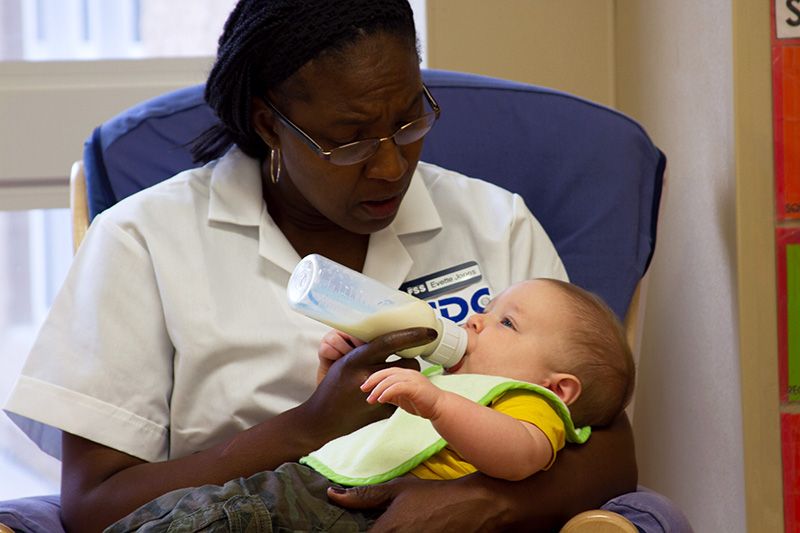 Responsive, nurturing adults to create feelings of safety
Responsive, nurturing adults to create feelings of safety- 接近成年人的地区(例如,滑翔机和沙发与成人舒适)
- 空间播放的东西是正确的尺寸和安全的探索
- Spaces to relax and recharge
- 安全地爬行,走路和爬上安全的地方
- 柔软的照明和窗户的自然光线
- Neutral-colored walls, furniture, and materials
- A space where noise is not too loud
- Space to observe, get to know, and play with peers
The environment sends strong messages to infants, toddlers, and families. It provides a story about what you expect, what you’ll do together, and what you value. A well-planned, safe environment can support engagement, exploration, and focused play. When infants and toddlers are not engaged, they may wander or display challenging behavior.
每个人都为早期的护理和学习环境带来独特的理解和偏好,并将对环境进行不同的反应。狗万app怎么下载作为婴儿和蹒跚学步的照顾者,您应该花时间反思您为婴儿,幼儿和家庭创造的环境。您可能会考虑支持社交情绪发展的额外方法,又可以防止挑战性行为。在本课程的应用部分中,您将有机会反思并确定您的环境支持婴儿和幼儿的社会情感发展的方式。
Family Engagement In Social-Emotional Development and Learning
Infants and toddlers begin to understand how to build and maintain relationships with others, how to respond to strong emotions, and what social-emotional behaviors are appropriate within their families. Families are central to infants’ and toddlers’ abilities to build trusting relationships, self-regulate, and explore. Research highlights that family sensitivity, including the warmth and skill with which families respond to their children’s needs, predicts children’s well-being and positive development in infancy and beyond.
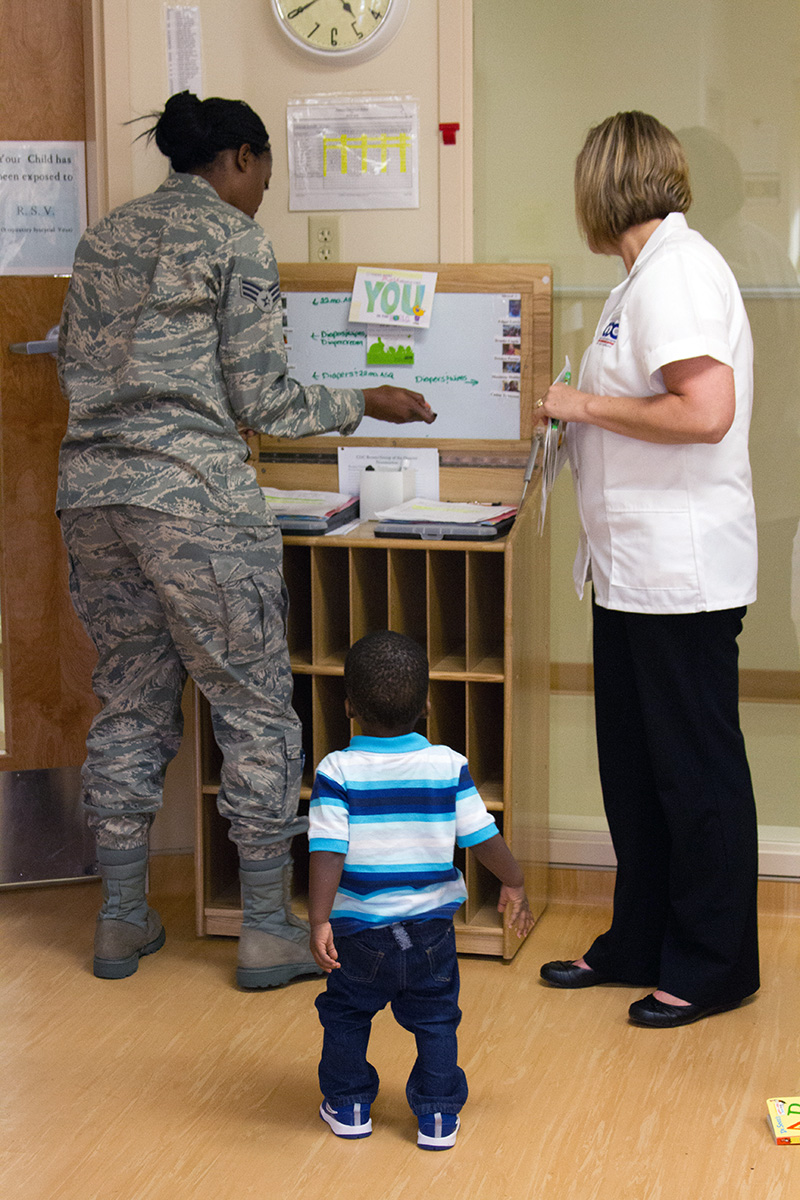
情况可能会影响并干扰家庭支持他们的幼儿社交发展的能力。这些情况,包括贫困,丧失就业,部署,父母抑制,家庭暴力和药物滥用,在一个家庭中产生高水平的压力。这种压力会对护理产生不利影响。越来越多的证据表明,在为高度强调的婴儿,幼儿及其家人服务时,支持婴儿和幼儿的社会情绪发展应该是优先事项。
Consider the following strategies to engage families in their children’s social-emotional development:
- Ask families to share their philosophies or thoughts about infant and toddler social-emotional development. Gather information about their backgrounds and beliefs.
- 创建关于家庭的感受和友谊的书籍,以便带回家。
- 为您的资源库中的家庭提供关于早期大脑和社会情感发展的资源。
- 观察一个家庭如何与婴儿或幼儿互动,并解释特定的行为是如何典型的发展阶段:“幼儿肯定忙碌而去!我打赌她让你搬家了。“
- 询问家庭分享他们的幼儿:“先生戈登,你怎么知道萨曼莎累了吗?饥饿的?”
- During an unhurried time, talk with families about a particular behavior: “Brice seems fussy after breakfast. I try sitting and reading a book with him, but it takes a while to help calm him. Do you have any ideas for me to try?”
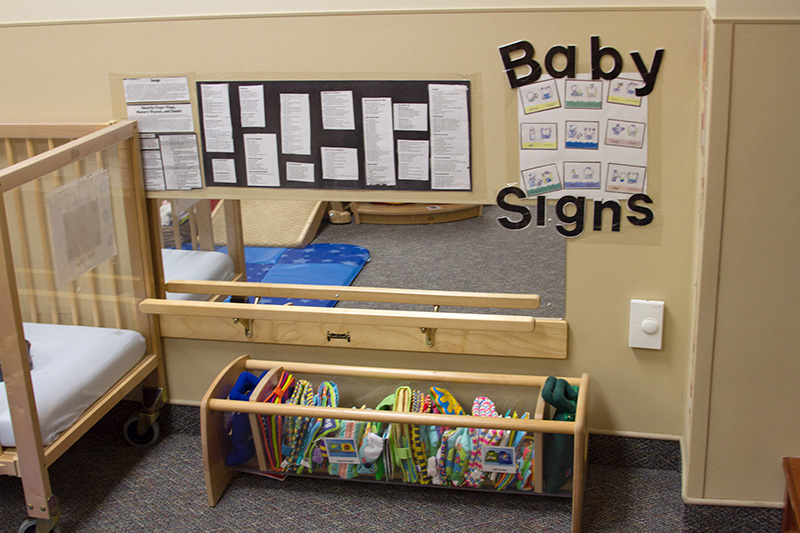
See
支持社会情绪发展的环境
做
The early care and learning environment affects the interactions of infants, toddlers, caregivers, and families. Rather than being in a large group with all of the children in your care, you can offer infants and toddlers cozy spaces so they can have opportunities to rest, observe, take a break from noise and activity, and recharge emotionally. Offering safe, relaxing spaces can help infants and toddlers build a sense of security and feel ready to engage. As an infant and toddler caregiver, you can:
- 提供软的地区nd inviting, include pillows and soft music.
- 包括可以轻松移动的椅子。
- 有充满感官玩具(挤压球,咔哒声,软材料)的箱子。
- Use a mattress with a washable cover to create a cozy floor space where infants can rest, observe, roll or crawl around.
- Use a tube or pop-up tent to offer a space where toddlers can sit, rest, and observe the activities in the room.
探索
花时间更多地考虑您在护理中为婴儿或幼儿提供的常规。下载并打印响应性护理习惯handout and document the ways you are using these routines to provide opportunities to build relationships and support self-regulation and exploration. Then, share and discuss your responses with a trainer, coach, or supervisor.
申请
下载并打印学ing More About My Environmenthandout, which contains a link to an additional resource that you can use to explore and better understand the ways your environment supports the social-emotional development of the infants and toddlers in your care. Then, share and discuss your responses with a trainer, coach, or supervisor.
词汇表
| 学期 | 描述 |
|---|---|
| Continuity of Care | An approach which supports the relationships between caregivers and infants and toddlers by keeping infants and toddlers in the same setting with a consistent team of providers over a period of time |
| 关系 | Sustained interactions with emotional connections that endure over time with particular, important meaning between the individuals involved |
| Routines | 一致,可预测的日常经验,如喂养,睡觉,尿布和清理时间 |
Demonstrate
Garcia-Coll, C. & Meyer, E. (2000). Cultural influences on parenting, in C.H. Zeanah, Handbook of Infant Mental Health, 2nd Ed., New York, N.Y.: Guilford Press.
Goleman,D。(2006)社会智力:人际关系的新科学。纽约,纽约:Bantam Dell。
Katz, J. & Snow, C. (2000). Language development in early childhood: The role of social interaction. Cryer, D.H. (Ed.) Infants and toddlers in out of home care (pp. 49-86). Baltimore: Brookes Publishing Co., Inc.
National Scientific Council on the Developing Child. (2004). Young children develop in an environment of relationships: Working paper no. 1. Retrieved from:http://developingchild.harvard.edu/index.php?cID=151
Raikes,H.&Edwards,C.,(2009)。在婴儿和蹒跚学步的舞蹈中延伸舞蹈。巴尔的摩,MD:布鲁克斯出版公司。
Shivers, E. (2004). Teacher-articulated perceptions & practices with families: Examining effective teaching in high quality child care settings. Early Education and Development, 15(2), 167-186.V.
Shonkoff, J., & Phillips, D. (2000). From neurons to neighborhoods: The science of early childhood development. Washington, DC: National Academy Press.
Shonkoff, J.P. (2009). Investment in early childhood lays the foundation for a prosperous and sustainable society. Retrieved from:http://www.child-encyclopedia.com/pages/pdf/importance-early-childhood-development.pdf..
Tarullo,L.B.,Atkins-Burnett,S.,Monohan,S。(2012)。婴幼儿和幼儿的照顾者儿童互动的质量。华盛顿特区:Mathematica政策研究。



 创建婴儿,幼儿和家庭看到自己的环境(例如,婴儿,幼儿和家庭,文化熟悉的材料和食物,使用家庭语言的沟通)。
创建婴儿,幼儿和家庭看到自己的环境(例如,婴儿,幼儿和家庭,文化熟悉的材料和食物,使用家庭语言的沟通)。 Responsive, nurturing adults to create feelings of safety
Responsive, nurturing adults to create feelings of safety